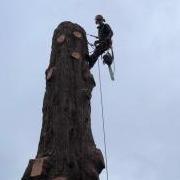Search the Community
Showing results for tags 'srt'.
-
I have been using the ZZ and chicane with the Drenaline rope and found that as it is quite a dynamic rope and you really have to push hard for limb walks or moving along the rope as it really bends round the chicane and causes a lot of friction. Can I have any rope suggestions that you guys have found to work really well with the ZZ and chicane.
-
Hi, I am posting this on behalf of a group of young engineers. We are we are working a design of a new SRT ascending/descending friction device that can be certified by CE. Our aim is to get the certification as well as to make the climbing process as comfortable as possible. Therefore, we would love to hear from real tree surgeons about what would they want this device to do to make their job easier. So we can have an idea about what would be more important to consider while designing this new device. If you can complete the survey bellow we would very appreciate it. https://www.surveymonkey.co.uk/r/DV3RJHG Thank you for your time.
-
Hi folks, in the process of making a zigzag wrench tether and before i jump straight into it i was just wondering if any of you had any photos of ones that you have made. I have a 10mm quick draw sling or a 12mm one depend on the distance above the links once finished, a couple of edelrid anti-twists to stiffen the tether up. DMM perfect-o and a bunch of heat shrink tubing. put all of that together and i think ill have a pretty slick tether that i can also add to a hitchclimber and hitch to perform the normal SRT set up.
-
Hi guys. I've wanting to buy some SRT equipment and I'm looking on GAT international's shop. The prices seem way too good to be true and I can't find any reviews on the website. Do any of you know if I can trust it?
-
Hi Guys, 2 great courses coming up in June for any South West Arbs out there looking to either take their business forward or update their SRT knowledge... Arboricultural Business Basics - 20th-21st June - With Paul Elcoat Using presentations and open discussion you will be well placed to reflect upon the position and performance of your business in today’s competitive market place. You will have the opportunity to discuss their own situations with Paul Elcoat, MD of Elcoat Ltd who has first-hand trouble shooting experience of around 200 arboricultural contracting businesses and Simon Cox, one of the Associations Technical Officers with experience in commercial contracting operations. Venue: Stonehouse Court Hotel, Stonehouse, Gloucestershire Stationary Rope Technique - 22nd June 2017 - With Scott Fraser Calling all climbers! Don’t miss out on this great SRT event in a stunning venue… A 1-day course organised by the AA Western Branch at the beautiful Buckfast Abbey, with Scott Fraser. This event will cover the theory, history and background of Stationary Rope Technique before moving on to practical demonstrations and application in the afternoon. The course provides information on significant hazards, components their selection and configuration and forces upon anchors. Thursday 22nd June £60
-
As an Employee are you aloud to climb single line for the company that you work for and I don't mean just for access, cutting as well. Cheers all
-
SINGLE ROPE TECHNIQUE (SRT) is a set of methods used to descend and ascend on the same single rope. The course will cover safe single rope techniques exploring the safest ways to use the correct ropes, knots, devices, safety cords and karabiners. Attendees will have a hands-on practical experience understanding the theory behind it, the devices, ropes and using them in the tree. This is a popular course and open to arborists of all abilities. You’ll meet other arborists and share ideas and experiences. Instructors Geoff Pugsley and Ben Rose are both very experienced users of SRT in their work and both share a keen interest in the latest developments. THE COURSE INCLUDES FISH & CHIPS AND REFRESHMENTS THROUGHOUT THE DAY AND IS SET IN THE BEAUTIFUL GROUNDS OF AMMERDOWN PARK. Book here now to secure your space! Call us for more info or to discuss group bookings on 01373 475540 https://www.sorbus-intl.co.uk/SRT-workshop-Sorbus-international
-
I'm fairly new to tree climbing and I have a mentor who has taught me SRT on a hitch climber pulley with a hitch and rope wrench, using canopy and base anchors. I've been practicing limbwalks on my own and have encountered debilitating resistance from the rope wrench when trying to feed slack. Every couple steps I take I have to use two hands to collapse the wrench on top of the hitch to allow myself another few inches of slack. Pulling slack back in is especially difficult. On straight vertical descents, with a little bounce to get the momentum going, the rope flows through the wrench as I would expect it to. The rope wrench I have is the newest edition which Ive been told has a larger diameter slick pin than the old edition and this leaves a smaller space for the rope to pass through. My climbing line is a 12mm Kernmaster and I weigh 135 lbs/61 kilos. The feedback I have got from another forum suggests trying a thinner diameter rope, something in the 11-11.6mm range. This is helpful, but don't plan to buy a completely new rope. Others say to try out the Hitchhiker. My mentor said to ask on forums for an older model of the rope wrench with the thinner slick pin. I wanted to gather some input from ArbTalk and ask if anyone does have an older rope wrench or hitchhiker they are willing to sell or trade?
-
We are proud to announce that we will be running a FREE* workshop with Taylor Hamel in conjunction with DMM! To makes things even better - there will also be FREE pizza! Taylor will be demonstrating advanced doubled rope techniques (DdRT) and the combination of doubled rope and stationary rope (SRT) systems for safe, efficient and confident work positioning and movement in trees. *We have introduced a £10 charge for reserving your place. This will be reimbursed in the form of a £10 voucher to spend on DMM gear at TREEKIT. Because there are only limited places, we hope this nominal charge will prevent people from booking on but not turning up. For more information or to reserve your place visit: Free DMM Workshop at TREEKIT Taylor Hamel is an arborist and contract climber with 15 years in the tree care industry. He travels extensively and has worked as a contract climber as well as presenting workshops across the US, Canada, UK/EU and Australia. In 2016 Taylor became the North American rep for DMM International. He has recently become certified as a SPRAT Level 1 Rope Access Technician. He is also the creator of the popular YouTube series [ame=https://www.youtube.com/watch?v=u4AlDpIZraA]Hitch Climber's Guide to the Canopy[/ame]
-
Marlow Ropes’ range of CE certified and ANSI compliant climbing, rigging and accessory lines are field proven and trusted by Arborists worldwide and manufactured in the UK (East Sussex) under rigorous ISO 9001:2015 quality standards. Whether it is hard wearing climbing ropes, super strong slings and throw lines or heat resistant accessory cords for prusik loops and friction hitches, Marlow excels in the innovation, quality and performance of arboriculture ropes. A question that we are asked is whether climbing lines should be spliced or not. As manufacturers of both options we see the benefits of both, but have seen the significant rise in Arborists using Single Rope Technique (SRT) in the industry, and therefore the changing nature of the ropes they are selecting for the job. There is becoming less of a need for arborists to always use the spliced option. In SRT the rope isn’t terminated at the harness which eliminates the need for a splice. Normally the argument is that a splice is smaller or slimmer and therefore keeps the harness area uncluttered, but this only matters if you are using the Double Rope Technique (DRT). Non-spliced climbing lines, such as our recently launched VEGA hold many benefits: · Non spliced ropes offer more flexibility for climbing from either end. This prevents one section of the rope getting more wear than another. · Non spliced ropes don’t need to be anchored at the end, in a short tree you could tie the rope in the middle, this further spreads the wear. · No splice means no diameter change. This means the rope is easy to thread up in ascenders and other rope control devices. It also makes rigging and retrieving easier, nothing to snag and can be rigged from either end. · No splice means a bit of damage near the end of the rope can be simply cut and re-sealed / labelled and the rope is ok for further service (albeit a little shorter). · Ropes wear in the eye- in a splice it will always be at the same point. In a knot it moves every time you tie it. Marlow’s new Vega is a CE EN1891 light-weight climbing rope that currently boasts the lowest elongation on the market (1.2%). Designed specifically for the new generation of mechanical climbing devices and modern climbing techniques. It is available as both spliced and non-spliced line and has a tough polyester core that provides extremely low elongation whilst also being energy absorbing, ideal for SRT climbing. The 24 plait polyester jacket offers exceptional flexibility and handling without compromising on durability. Available in lime or orange. Look for the Marlow Black Marker. To find out more about using the non-spliced Vega contact us at [email protected] or visit www.marlowropes.com to locate your nearest Arb Shop and Marlow stockist. View full article
-
- climbing lines
- splicing
-
(and 6 more)
Tagged with:
-
Hi, I have an upcoming job that I wanted to get advice from others on. It is a dead loblolly pine that is around 100-200 feet high and surrounded by fences. The fence isn’t much of a problem and I think it can be avoided or replaced if worst comes to worst. My main concern is safety for me the climber and the ground crew. The drop zone if I try to save the fence is small. It has very few remaining limbs. There are no other trees around that I could tie into for safety so pole climbing seems to be my only option. Are there any safety tips? I’m thinking about purchasing a tree squeeze in case of gaff slips but I have never used one.
-
Sorry if this topic has come up before. Climber here who has only climbed ddrt, I’m looking to get into SRT. What rope would everyone recommend for SRT AND drt. Something stiff enough for SRT but also able to tie knots in as I would use it for both methods, I was thinking either drenaline or tachyon but if anyone has any other suggestions it would be greatly appreciated. It will be for a rope runner and jetstep. would 45 metres be long enough to do most trees with a base anchor because pulling 60m through on doubled rope would be pain. also a good knee ascender suggestion would be appreciated too. thanks
-
To Splice or Not to Splice? SRT & Non-Spliced Climbing Lines
Marlow Ropes (Emma) posted an article in Articles
Marlow Ropes’ range of CE certified and ANSI compliant climbing, rigging and accessory lines are field proven and trusted by Arborists worldwide and manufactured in the UK (East Sussex) under rigorous ISO 9001:2015 quality standards. Whether it is hard wearing climbing ropes, super strong slings and throw lines or heat resistant accessory cords for prusik loops and friction hitches, Marlow excels in the innovation, quality and performance of arboriculture ropes. A question that we are asked is whether climbing lines should be spliced or not. As manufacturers of both options we see the benefits of both, but have seen the significant rise in Arborists using Single Rope Technique (SRT) in the industry, and therefore the changing nature of the ropes they are selecting for the job. There is becoming less of a need for arborists to always use the spliced option. In SRT the rope isn’t terminated at the harness which eliminates the need for a splice. Normally the argument is that a splice is smaller or slimmer and therefore keeps the harness area uncluttered, but this only matters if you are using the Double Rope Technique (DRT). Non-spliced climbing lines, such as our recently launched VEGA hold many benefits: · Non spliced ropes offer more flexibility for climbing from either end. This prevents one section of the rope getting more wear than another. · Non spliced ropes don’t need to be anchored at the end, in a short tree you could tie the rope in the middle, this further spreads the wear. · No splice means no diameter change. This means the rope is easy to thread up in ascenders and other rope control devices. It also makes rigging and retrieving easier, nothing to snag and can be rigged from either end. · No splice means a bit of damage near the end of the rope can be simply cut and re-sealed / labelled and the rope is ok for further service (albeit a little shorter). · Ropes wear in the eye- in a splice it will always be at the same point. In a knot it moves every time you tie it. Marlow’s new Vega is a CE EN1891 light-weight climbing rope that currently boasts the lowest elongation on the market (1.2%). Designed specifically for the new generation of mechanical climbing devices and modern climbing techniques. It is available as both spliced and non-spliced line and has a tough polyester core that provides extremely low elongation whilst also being energy absorbing, ideal for SRT climbing. The 24 plait polyester jacket offers exceptional flexibility and handling without compromising on durability. Available in lime or orange. Look for the Marlow Black Marker. To find out more about using the non-spliced Vega contact us at [email protected] or visit www.marlowropes.com to locate your nearest Arb Shop and Marlow stockist.-
- climbing lines
- splicing
-
(and 6 more)
Tagged with:
-
It is an exciting time for tree climbers. Equipment and techniques are developing to not only promote safe working practices but to allow you to work smarter and not harder. The working life expectancy of a climber can be prolonged with hopefully less wear and tear being picked up on the way. One such development in Arb climbing is the use of SRT climbing systems. SRT has been used for a number of years for canopy access, borrowing ideas and kit from rock climbing, caving etc. Traditional ascenders have always been great a capturing progress but have lacked the ability to descend should the need arise. In the last few years people have gone out on a limb like Morgan Thompson with his Unicender, Kevin Bingham with the Rope Wrench and then the Rope Runner, to develop tools that capture ascent but can be used to descend aswell. Another such pioneer in SRT Work positioning is Gordon Svedberg AKA Surveyor on forums such as The Buzz, Treehouse and Arbtalk. After producing hybrid devices such as the OAR, Gordon came up with the idea of the Compact Bulldog Bone. Having had the idea and developed prototypes, Gordon put out his design to a number of local arbs for testing and feedback via the Treebuzz internet forum in August 2014. This not only proved to be a great method of getting the Bone out there, but provided a valuable source of information and feedback from the users to the developer. Gordon took on board the feedback and over the next few months tried to incorporate the likes and dislikes he had received by tweaking the design of the Bone to allow for different users desires and rope types. The main aims being to develop one device to allow the climber to seemlessly ascend and descend and be mid-line attachable with no droppable parts. The Bone goes on the rope in seconds and can be removed in the same time frame. The Bone is made of simple parts that are easy to replace. The result of this is a Mechanical Ascender/descender, that is easy to modify and tune to your exact requirements. Although being mechanical, it operates with a very hitch like feel. For more information on the development process and the history of the device, pull up a chair, grab and drink and a 'sammich' and log onto Gordon ships the BDB after having received a signed disclaimer and payment for the product and postage. The BDB ships with instructions and 3 different sized bollards to be used on the top arm to control friction for ropes of different diameter. I received my BDB in January after reading the hype on various internet forums. I was not disappointed. First impression were of a solid, robust (read bombproof) piece of kit that I couldn't wait to use. After reading about the various modifications and development I already felt like I knew exactly how it would respond. After a couple of goes low and slow, I tried the BDB on my favourite rope, Cougar Blue with the 5/8th bollard. It responded very much like a hitch but I felt it needed a bit of time to bed in, or I needed to get used to it at least. The first 4 or 5 climbs I had on the BDB were in the rain, I was crying for a dry day. Even in the rain, once the ascent was dialled in with a HAAS and pantin, the BDB ate the rope for lunch. Desending was a bit of an on off affair till you get used to it. After a particular wet day, working over a goose enclosure my rope needed a wash... WOW! What a difference that made. The BDB literally tends slack so easily you can clip into a neck tether or chest harness and freeclimb the tree and it takes it all in with minimum sitback. My BDB self tends with approx 20 foot of line below me. Same deal with spikes, either spike the tree and it will tend depending on the rope angle or clip into a pantin or spikecender and up you go. The more I have used this device the more I am growing to love it. There has been some initial wear on the spine as the ropes and device get to know each other, but nothing to worry about at this stage. One of the main selling points of this device is how easy it is to set it on the rope. Everything is connected so there is no worry of dropping any parts. It is a case of threading the rope into the arms, bending the rope and sliding a link over the rope and locking clasp. This is just as easy to remove, just in reverse, making change overs or redirects less of a challenge and reducing the risk of getting your climbing device jammed in a fork. As mentioned, there are various modifications you can do to personalise your Bone. The only thing I have done is adjust the tending point from the spine to the top arm. In doing so, the top arm releases allowing the rope to flow even smoother through it without compromising safety. There are a few vids and reviews of the BDB on youtube. For more information on the Compact Bulldog Bone, please read the Arbtalk thread posted above. If you want to contact Gordon directly to order or simply query his design then his email is [email protected] Richard Rule Freelance Climber
-
Hi guys Am sure this question has probably been asked before, but couldn't seem to find a thread which properly answered my question! Basically I am looking to buy a new harness, mainly for rec climbing on the weekends and have been looking at the Petzl Sequoia (have also been looking at the Tree Motion but not sure I can justify the price for weekend rec climbing!) Anyway although I am currently climbing DdRT I am keen to explore SRT in the near future and was wondering whether it would be worth buying the Petzl Sequoia SRT version? Will this work ok with DdRT as well? The only difference I can see from the standard Sequoia is that the SRT version has attachment points for a chest harness, but is there more to it than this? Any advice appreciated Tom
-
Hi guys, I'm just after some advice, in case any of you have run into this situation before. Back in 2010 I came up with a different way of splicing the tether for an SRT system. Cobbled together with the Kong Futura and some other kit, this became the . I wrote about it in this handout, then started making these kits for an Australian gear supplier and for my friends. Now I find that Wesspur have brought out their own - quite frankly somewhat shoddy - knock-off version. I wrote to them to try and get them to - at least - attribute the design, and their first reply was fairly courteous: So far so good, right? Unfortunately since then they have decided to completely ignore every single one of my emails, not even having the basic courtesy to send a reply. So, long story over, any advice? Anyone been in this situation before and found a way to move forward? At the end of the day, it wasn't patented or anything - I mean, why bother, look at how the Faltheimer got ripped off by everyone - and it seems a shame to go down that road anyway. But is that the only answer?
-
So a many of you have probably already seen the YouTube videos of simplified SRT rescue with the Rope Runner [ame=http://www.youtube.com/watch?v=zzanEuUuiGk]Rescue One[/ame] [ame=http://www.youtube.com/watch?v=bZmT6ujFCAo]Rescue Two[/ame] Very cool. Of course, it's potentially a lot of force on the tie-in point (if it's only in a single crotch,) but it's no big deal if the victim is tied in to a solid point on a strong, structurally sound tree if you ask me. While playing around with this during a rescue training, my co-worker John Davis came up with a variation for rescuing a victim climbing on a doubled rope system. To accomplish this, the rescuer climbs the victim's line, acting as a counterweight. After reaching the victim, the rescuer can package the victim, then disconnect their split tail or eye-to-eye. The rescuer can then lower themselves to the ground. Once on the ground, rescuer can continue to allow rope to pass through the Rope Runner, belaying the packaged victim down to the ground much like a belayer would lower a rock climber. It's fast and efficient for some circumstances, provided the victim can be packaged, is in a lowerable location, and the tie-in point is strong enough to support the weight of two climbers. Thoughts?
- 1 reply
-
- srt
- roperunner
-
(and 2 more)
Tagged with:
-
i cant remember the name for the srt friction knot used with that realy long friction line. can anyone help?
-
Hey all, anyone know of any splicing workshops coming up in New Zealand this year?
- 10 replies
-
Hi all, A quick request for your input, if you have the time. I was recently involved in running an advanced climbing workshop, for which I and some others made the handouts below. The handouts have been really popular, and we're now talking about trying to make them into 'living documents', kind of like a low-budget wikipedia for climbers. So we'd really appreciate (constructive) criticism and new ideas from all over the globe. Single Rope Technique Working the Angles Introduction to Redirects Knots for Arboriculture Any criticism or feedback, please email me at [email protected]
-
Hi guys, I have just started at a new company that provide climbing inspections but some of their guys don't have CS tickets just the level 1 rope access technician qualification. What i would like to know is can we work together with our qualifications and we will be covered by the insurance to rescue each other? I've trawled the internet and couldn't find anything that was crystal. Look forward to anyones feedback! Cheers Adam
-
I have just started at a new company that provide climbing inspections but some of their guys don't have CS tickets just the level 1 rope access technician qualification. What i would like to know is can we work together with our qualifications and we will be covered by the insurance to rescue each other? I've trawled the internet and couldn't find anything that was crystal. Look forward to anyones feedback! Cheers Adam
-
<iframe width="1280" height="720" src="//www.youtube.com/embed/1VoQA5HTNWg?rel=0&controls=0&showinfo=0" frameborder="0" allowfullscreen></iframe>

















